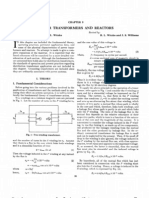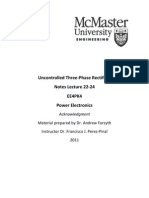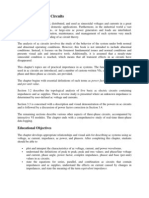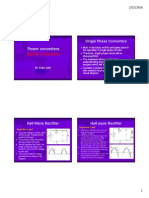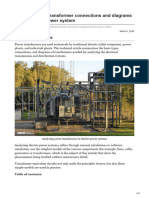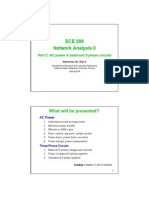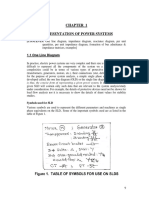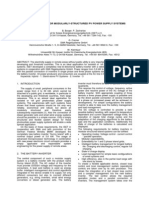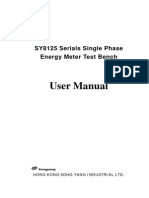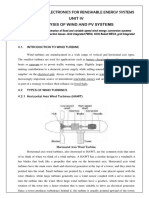AC Power and PU Sys
AC Power and PU Sys
Uploaded by
QM_2010Copyright:
Available Formats
AC Power and PU Sys
AC Power and PU Sys
Uploaded by
QM_2010Original Description:
Copyright
Available Formats
Share this document
Did you find this document useful?
Is this content inappropriate?
Copyright:
Available Formats
AC Power and PU Sys
AC Power and PU Sys
Uploaded by
QM_2010Copyright:
Available Formats
Grady, /www.ece.utexas.
edu/~grady/, 10/23/01
1 - 1
Section 1. Definitions and Per Unit System
Definitions related to power. RMS values, active and reactive power, power factor, power flow
in transmission lines. Review of per unit system and the advantages that it offers.
1.1 Single-Phase Definitions
The root-mean-squared (RMS) value of a periodic voltage (or current) waveform is
T t
t
RMS
dt t v
T
V ) (
1
2
, where T is the period of v(t).
If v t V t ( ) sin( ) + , where V is the peak value, then using
2
) 2 cos( 1
) ( sin
2
A
A
,
RMS
V
becomes
2
V
V
RMS
.
Instantaneous power flowing to a load, using the sign convention shown in Figure 1.1, is defined
as
) ( ) ( ) ( t i t v t p .
v(t)
i(t)
+
-
p(t) = v(t) i(t)
--->
---> p(t)
Figure 1.1: Instantaneous Power Flowing Into a Load
Average power flowing to a load is defined as
T t
t
dt t p
T
P ) (
1
, where T is the period of ) (t p .
If ) sin( ) ( + t V t v , ) sin( ) ( + t I t i , then the instantaneous power becomes
[ ] ) 2 cos( ) cos(
2
) ( ) ( ) ( + + t
VI
t i t v t p .
Grady, /www.ece.utexas.edu/~grady/, 10/23/01
1 - 2
Note that ) (t p has double-frequency and time-invariant components. The average value of ) (t p
is the time-invariant component, or
) cos(
2
VI
P .
Since
2
V
V
RMS
and
2
I
I
RMS
, then
) cos(
RMS RMS
I V P ,
where ) cos( is known as the displacement power factor (pf).
Reactive power Q is defined as
) sin(
RMS RMS
I V Q .
Since 1 ) ( cos ) ( sin
2 2
+ x x , then
2 2 2 2
RMS RMS
I V Q P + .
Complex power S is defined as
jQ P S + ,
so that
{ } S P al Re , { } S Q Imag .
The magnitude of S is
2 2
| | Q P S + ,
which is identical to
RMS RMS
I V S | | .
Using voltage and current phasors | |
~
RMS
V V and | |
~
RMS
I I , the product
*
~ ~
I V is
) sin( | | | | ) cos( | | | | ) ( | | | | +
RMS RMS RMS RMS RMS RMS
I V j I V I V
.
Therefore,
Grady, /www.ece.utexas.edu/~grady/, 10/23/01
1 - 3
*
~ ~ ~
I V jQ P S + .
When I
~
lags V
~
, Q is positive, and the power factor is lagging. When I
~
leads V
~
, Q is
negative, and the power factor is leading. Thus, an inductive load has a lagging power factor and
absorbs Q, while a capacitive load has a leading power factor and produces Q.
The total power factor pf is defined as
S
P
pf .
For sinusoidal systems, total power factor is identical to displacement power factor defined
previously as the cosine of the relative phase angle between voltage and current.
If P and pf are given, Q can be calculated using
,
_
1
1
2
2
2
2
2
2 2 2
pf
P P
pf
P
P S Q , or
1
1
2
pf
P Q .
The relationships among P, Q, S, and pf are shown in the power factor triangle given in Figure
1.2.
P
Q
S
pf = ------
P
S
Figure 1.2: Power Factor Triangle
The impact of power factor on the Q/P ratio is given below in the Table 1.1.
Grady, /www.ece.utexas.edu/~grady/, 10/23/01
1 - 4
pf Q / P
1.0 0.00
0.9 0.48
0.8 0.75
0.707 1.00
0.6 1.33
Table 1.1: Impact of Power Factor on Reactive Power Q
Now, consider the power flow through a purely inductive circuit element, such as a lossless
transmission line or transformer shown in Figure 1.3.
j X
+
-
+
-
P + j Q -->
Vs Vr r s
Figure 1.3: Power Flow Through a Purely Inductive Circuit Element
The active and reactive power flows, measured at the sending end S, can be shown to be
) sin(
R S
R S
X
V V
P , [ ] ) cos(
R S R S
S
V V
X
V
Q .
Usually, ) (
R S
is small, so that
) (
R S
P , [ ]
R S
S
V V
X
V
Q .
Therefore, in inductive circuit elements, P tends to be proportional to voltage angle difference,
and Q tends to be proportional to voltage magnitude difference.
1.2 Three-Phase Definitions
In a three-phase system, the total power (instantaneous, average, or complex) is the sum of the
powers of the three individual phases, or
Grady, /www.ece.utexas.edu/~grady/, 10/23/01
1 - 5
) ( ) ( ) ( ) ( t p t p t p t p
c b a
+ + , instantaneous power,
c b a
P P P P + + , average power,
) ( ) ( ) (
c c b b a a
jQ P jQ P jQ P S + + + + + , complex power.
The voltages must be measured with respect to a common reference point. In a four-wire system,
the common reference should be the neutral wire (or ground). In a three-wire system, the
common reference can be a derived neutral, or one of the phases (in which case the power on the
reference phase is zero since the corresponding voltage is zero).
1.3 Single-Phase Per Unit System
Advantages of the per unit system:
1. Transformers can be replaced by their equivalent series impedances.
2. Equipment impedances can be easily estimated since their per unit impedances lie within a
relatively narrow range.
Define four quantities in per unit of their respective base values:
volts
volts
V
V
V
base
pu
,
amps
amps
I
I
I
base
pu
,
voltamps
voltamps
S
S
S
base
pu
,
ohms
ohms
Z
Z
Z
base
pu
.
The relationships among the bases are
base base base
I V S , and
base
base
base
I
V
Z .
Once two base variables are specified, the other two base variables may be calculated.
A convenient relation, derived from the two above equations, is
base
base
base
base
base base base base
Z
V
Z
V
V I V S
2
.
Consider a transformer with an
2 1
: N N turns ratio and series impedance, reflected on side 1,
equal
1 L
Z .
1 L
Z can be reflected to side 2 using
Grady, /www.ece.utexas.edu/~grady/, 10/23/01
1 - 6
1
2
1
2
2 L L
Z
N
N
Z
1
]
1
.
Let side 1 and side 2 have base values designated by subscripts S1 and S2. Then
1
2
1
1
base
base
base
S
V
Z ,
2
2
2
2
base
base
base
S
V
Z ,
Expressing the transformer impedance on the two respective bases yields
2
1
1 1
1
base
base L
PU L
V
S Z
Z ,
2
2
2 2
2
base
base L
PU L
V
S Z
Z .
If
2 1 B B
S S , the two above equations may be combined so that
PU L
base
base
PU L
Z
V
V
N
N
Z
1
2
2
1
2
1
2
2 1
]
1
1
]
1
.
Substituting the relation between
1 L
Z and
2 L
Z yields
PU L
base
base
PU L
Z
V
V
N
N
Z
1
2
2
1
2
1
2
2 1
]
1
1
]
1
.
Therefore, if
1
2
1
2
N
N
V
V
base
base
, then
PU L PU L
Z Z
1 2
.
Hence, if a common voltampere base is chosen on both sides of the transformer, and if the
voltage bases are chosen so that they vary according to the transformer turns ratio, then the per
unit series impedance of the transformer is the same value on both sides.
When analyzing a circuit with many transformers, a common voltampere base should be chosen
throughout the circuit, and a voltage base should be chosen at one location. The voltage base
must vary across the circuit according to the transformer turns ratios.
When analyzing a circuit in per unit, if the bases are chosen according to the above rules,
transformers can be replaced by their equivalent per unit series impedances, and their turns can
be ignored.
A manufacturer usually provides the impedance of a transformer on the transformers rated
voltage and power bases. However, when solving a power network circuit, the power and
voltage bases must vary according to the above rules, and they may not equal the manufacturer-
Grady, /www.ece.utexas.edu/~grady/, 10/23/01
1 - 7
specified bases. Per unit impedances, specified on one base, may be converted to a new base as
follows:
Given
old base
old PU
Z
Z
Z
,
,
, on bases
old base
V
,
and
old base
S
,
,
new PU
Z
,
on new bases
new base
V
,
and
new base
S
,
is
1
1
]
1
1
1
]
1
2
,
,
,
2
,
,
,
, ,
,
,
new base
new base
old base
old base
old PU
new base
old base old PU
new base
ohms
new PU
V
S
S
V
Z
Z
Z Z
Z
Z
Z .
1.4 Three-Phase Per Unit System
The same advantages apply to a three-phase system if the following rules are obeyed:
1. A common three-phase voltampere base is used throughout the system, where
1 , 3 ,
3
base base
S S .
2. Once selected at a point in the network, the three-phase voltage base must vary according to
the line-to-line transformer turns ratios.
Convenient formulas relating single-phase to three-phase bases are given below.
base neutral line base base
I V S
, 1 ,
,
1 , 3 ,
3
base base
S S ,
[ ]
3 ,
2
,
3 ,
,
2
1 ,
2
,
3 /
3 /
base
line line base
base
line line base
base
neutral line base
base
S
V
S
V
S
V
Z .
You might also like
- Power Transformers and ReactorsDocument49 pagesPower Transformers and ReactorsroyclhorNo ratings yet
- Ybus Matrix With Regulating Transformer - Self Study TopicDocument21 pagesYbus Matrix With Regulating Transformer - Self Study TopicSankar MuthuswamyNo ratings yet
- Section 1. Definitions and Per Unit System: V T V TDTDocument7 pagesSection 1. Definitions and Per Unit System: V T V TDTpepemirasNo ratings yet
- Fundamentals Grady Notes June 2007 PrintDocument389 pagesFundamentals Grady Notes June 2007 PrintDavid VillarganNo ratings yet
- Review of Basic Concepts - Professor J R Lucas 2.1 Single Phase PowerDocument9 pagesReview of Basic Concepts - Professor J R Lucas 2.1 Single Phase PowerNormanSulimaNo ratings yet
- Three-Phase To Two-Phase/One-Phase Conversion Using TWO TRANSFORMERS (Scott Connection)Document13 pagesThree-Phase To Two-Phase/One-Phase Conversion Using TWO TRANSFORMERS (Scott Connection)Bhavani Chandra UniqueNo ratings yet
- Fundamentals of Power Systems PDFDocument13 pagesFundamentals of Power Systems PDFSurender ReddyNo ratings yet
- Active Load Balancing in A Three-Phase Network by Reactive Power CompensationDocument37 pagesActive Load Balancing in A Three-Phase Network by Reactive Power Compensationvivian phamNo ratings yet
- 32.power System Study-Sc, RC & Dynamic TestingDocument136 pages32.power System Study-Sc, RC & Dynamic TestingAbhishek Kulshreshtha100% (2)
- 2536 TutorialSymmetrical AA 20120724Document98 pages2536 TutorialSymmetrical AA 20120724jbrenner85No ratings yet
- Flexible AC Transmission SytemDocument31 pagesFlexible AC Transmission SytemMuhammad AbuzarNo ratings yet
- Power Systems Analysis I NotesDocument30 pagesPower Systems Analysis I NotesbrendamulureNo ratings yet
- Novel Three-Phase PWM Voltage-Fed Rectifier With An Auxiliary Resonant Commutated Pole LinkDocument9 pagesNovel Three-Phase PWM Voltage-Fed Rectifier With An Auxiliary Resonant Commutated Pole LinkGabriel MejiaNo ratings yet
- Solution KEE601Document36 pagesSolution KEE601ky708090100No ratings yet
- Part One Waveguides and CavitiesDocument9 pagesPart One Waveguides and CavitiesnananghadisodikinNo ratings yet
- Factor Affecting Characteristic of Voltage Sag Due To Fault in The Power SystemDocument12 pagesFactor Affecting Characteristic of Voltage Sag Due To Fault in The Power SystemmukeshhNo ratings yet
- Uncontrolled Three Phase RectifiersDocument19 pagesUncontrolled Three Phase RectifiersTetsusaigaNo ratings yet
- Self Excitation of Induction Motors With Series CapacitorsDocument7 pagesSelf Excitation of Induction Motors With Series CapacitorsDiego Nicolás López-RamírezNo ratings yet
- J N,-LN: ReferencesDocument3 pagesJ N,-LN: ReferencesshirtquittersNo ratings yet
- 2.transmission Line TheoryDocument20 pages2.transmission Line Theoryhacker_05No ratings yet
- Slot WindingDocument22 pagesSlot WindingFitri Senpai80% (5)
- Lecture Power System RepresentationDocument8 pagesLecture Power System RepresentationRaniel Rey CantorNo ratings yet
- 2011 - A Prokhorov - Monitoringchangesinmechanicalstateofwindingsofpowe (Retrieved 2016-11-25)Document6 pages2011 - A Prokhorov - Monitoringchangesinmechanicalstateofwindingsofpowe (Retrieved 2016-11-25)emilioaraNo ratings yet
- Simulation of Series Active Filter For Unbalanced Loads: Greatkalai - Sasi@yahoo - Co.inDocument6 pagesSimulation of Series Active Filter For Unbalanced Loads: Greatkalai - Sasi@yahoo - Co.inphuongnhooNo ratings yet
- ECE320 Notes Part1 PDFDocument132 pagesECE320 Notes Part1 PDFrushi777No ratings yet
- T1035 PDFDocument8 pagesT1035 PDFCarlos Lino Rojas AgüeroNo ratings yet
- Electrical Energy Generation Electrical Energy GenerationDocument10 pagesElectrical Energy Generation Electrical Energy GenerationKadhane NavnathNo ratings yet
- Resonancia SubsincronaDocument16 pagesResonancia SubsincronaSheyla Elizabeth Santamaria Roque100% (1)
- A Voltage Regulator For Power Quality Improvement in LowDocument10 pagesA Voltage Regulator For Power Quality Improvement in LowKuncham ShivareddyNo ratings yet
- Short Circuit Current Forces PDFDocument4 pagesShort Circuit Current Forces PDFDaniel MemijeNo ratings yet
- EE423 Fault Analysis NotesDocument26 pagesEE423 Fault Analysis NotesadnanNo ratings yet
- Power System Analysis, Transformer Per UnitDocument31 pagesPower System Analysis, Transformer Per UnitSahib Ur RehmanNo ratings yet
- Review For MidtermDocument44 pagesReview For MidtermMettah Conrad BamehNo ratings yet
- Load Flow AnalysisDocument56 pagesLoad Flow AnalysislaxmanNo ratings yet
- Syllabus:: Electrical Dept. Electrical Power III Dr. Omar AlazzawiDocument97 pagesSyllabus:: Electrical Dept. Electrical Power III Dr. Omar AlazzawiAkram KhasheaNo ratings yet
- Maximum Power Transfer Capability Within The Voltage Stability Limit of Series and Shunt Compensation Schemes For AC Transmission SystemsDocument9 pagesMaximum Power Transfer Capability Within The Voltage Stability Limit of Series and Shunt Compensation Schemes For AC Transmission SystemsPhamNangVanNo ratings yet
- Lecture 2-E-Force FieldDocument76 pagesLecture 2-E-Force Fieldapi-307330449No ratings yet
- Power Ssytem Analysis Solution VII Sem 2013Document19 pagesPower Ssytem Analysis Solution VII Sem 2013hodeegits9526No ratings yet
- Introduction To AC CircuitsDocument5 pagesIntroduction To AC CircuitsKeerthi Keerthana100% (1)
- (R-C) Series CircuitDocument5 pages(R-C) Series CircuitZalcavel GearNo ratings yet
- State-Space Average Modelling of 6-And 12-Pulse Diode RectifiersDocument10 pagesState-Space Average Modelling of 6-And 12-Pulse Diode RectifiersSandy RonaldoNo ratings yet
- Module 1 Representation of PU SystemDocument14 pagesModule 1 Representation of PU SystemJay JNo ratings yet
- A Single-Phase Voltage Controller With An Inductive LoadDocument7 pagesA Single-Phase Voltage Controller With An Inductive Loadhamza abdo mohamoud100% (2)
- AC-DC Converters PDFDocument9 pagesAC-DC Converters PDFrizwan100% (1)
- Lecture1-Review of Power System Networks, Complex Power, and Per UnitsDocument29 pagesLecture1-Review of Power System Networks, Complex Power, and Per Unitsleo232100% (1)
- Lecture FACTSDocument17 pagesLecture FACTSGetahun Shanko KefeniNo ratings yet
- An Overview of Transformer Connections and Diagrams in The Electric Power SystemDocument9 pagesAn Overview of Transformer Connections and Diagrams in The Electric Power SystemMr AlAliNo ratings yet
- Chapter No: 04: Measurement of Power & Power Factor CorrectionDocument26 pagesChapter No: 04: Measurement of Power & Power Factor CorrectionChandrakant BhattarNo ratings yet
- 2 - 209 - ACPower3PhaseAC Power - 7may2014Document23 pages2 - 209 - ACPower3PhaseAC Power - 7may2014gazpeitia1No ratings yet
- Electrostatics: Topics To CoverDocument16 pagesElectrostatics: Topics To CoverNissam SidheeqNo ratings yet
- 06 - Yskawi SkiDocument11 pages06 - Yskawi SkiFaisal JavaidNo ratings yet
- Notes On Power System Load Flow Analysis Using An Excel WorkbookDocument20 pagesNotes On Power System Load Flow Analysis Using An Excel WorkbookkittuNo ratings yet
- Microwave Network AnalysisDocument47 pagesMicrowave Network AnalysisbhushandabadeNo ratings yet
- What Are Scattering Parameters?Document16 pagesWhat Are Scattering Parameters?shaheerdurraniNo ratings yet
- Representation of Power Systems: 1.1 One Line DiagramDocument17 pagesRepresentation of Power Systems: 1.1 One Line DiagramDr. Gollapalli Naresh100% (1)
- Single Phase Half Wave Controlled RectifierpdfDocument14 pagesSingle Phase Half Wave Controlled RectifierpdfRîtzî Saxena92% (37)
- STEM: Science, Technology, Engineering and Maths Principles Teachers Pack V10From EverandSTEM: Science, Technology, Engineering and Maths Principles Teachers Pack V10No ratings yet
- Feynman Lectures Simplified 2B: Magnetism & ElectrodynamicsFrom EverandFeynman Lectures Simplified 2B: Magnetism & ElectrodynamicsNo ratings yet
- Machlens Quiz 2 SolutionDocument3 pagesMachlens Quiz 2 SolutionQM_2010No ratings yet
- Machien Quiz 2 QuestionDocument2 pagesMachien Quiz 2 QuestionQM_2010No ratings yet
- Quiz 1 QuestionDocument2 pagesQuiz 1 QuestionQM_2010No ratings yet
- J. R. Lucas - Three Phase TheoryDocument19 pagesJ. R. Lucas - Three Phase TheoryQM_2010No ratings yet
- Quiz 1 SolutionDocument3 pagesQuiz 1 SolutionQM_2010No ratings yet
- Medium Voltage Technical Guide: Basics For MV Cubicle DesignDocument84 pagesMedium Voltage Technical Guide: Basics For MV Cubicle DesignVasu Devan100% (3)
- Common VBA Statements For Excel VBA ProgrammingDocument4 pagesCommon VBA Statements For Excel VBA ProgrammingQM_2010100% (1)
- About Mena EpacDocument1 pageAbout Mena EpacQM_2010No ratings yet
- Battery Inverter For Modularly Structured PV Power Supply SystemsDocument4 pagesBattery Inverter For Modularly Structured PV Power Supply SystemsQM_2010No ratings yet
- 1 - Effects of Harmonics On Power Systems - Part 1Document7 pages1 - Effects of Harmonics On Power Systems - Part 1QM_2010No ratings yet
- Alternating Current Circuits Based On Serway and Jewett 6edDocument30 pagesAlternating Current Circuits Based On Serway and Jewett 6edQM_2010No ratings yet
- 5 - Correcting Power Factor at Your Motor TerminalsDocument2 pages5 - Correcting Power Factor at Your Motor TerminalsQM_2010No ratings yet
- 4 - A Primer On Power Factor CorrectionDocument7 pages4 - A Primer On Power Factor CorrectionQM_2010No ratings yet
- Power Flow Analysis by Ramaswamy NatarajanDocument377 pagesPower Flow Analysis by Ramaswamy Natarajanbvraju21285% (13)
- Voltage Induction in Parallel Transmission CircuitsDocument9 pagesVoltage Induction in Parallel Transmission CircuitsQM_2010No ratings yet
- GOM 07. Guideline For Inspection of GECOL EquipmentsDocument256 pagesGOM 07. Guideline For Inspection of GECOL EquipmentsQM_2010No ratings yet
- Surge ArresterDocument16 pagesSurge ArresterQM_2010No ratings yet
- Battery SizingDocument3 pagesBattery SizingQM_201033% (3)
- Solaredge Grid Tie InverterDocument2 pagesSolaredge Grid Tie InverterMayur HiwarkarNo ratings yet
- EEE R19 II Year Course Structure SyllabiDocument54 pagesEEE R19 II Year Course Structure Syllabiuday krishnaNo ratings yet
- Electrical Technology Nov 2018 Power Systems FINAL Memo Eng.Document14 pagesElectrical Technology Nov 2018 Power Systems FINAL Memo Eng.skhonjwayo78No ratings yet
- Eee1001 - Electrical Circuits and Systems: Abhishek JoshiDocument42 pagesEee1001 - Electrical Circuits and Systems: Abhishek JoshiDIPTANU SAHANo ratings yet
- Electrical Engineering Sem-2 All Question BankDocument2,178 pagesElectrical Engineering Sem-2 All Question BankGAURAV GUPTANo ratings yet
- Drive Lab ManualDocument94 pagesDrive Lab ManualKeerthana SahadevanNo ratings yet
- EEP 2301 Notes22Document37 pagesEEP 2301 Notes22dennisnyala02No ratings yet
- Data Sheet of Cummins 500kva by IntranusaDocument9 pagesData Sheet of Cummins 500kva by IntranusaDeni DendenNo ratings yet
- 123 2.ministar Manual Rev3 EngDocument44 pages123 2.ministar Manual Rev3 EngMilovan JanićijevićNo ratings yet
- The Complete Guide To The Square Root of Three in Power CalculationsDocument31 pagesThe Complete Guide To The Square Root of Three in Power CalculationsTamjidNo ratings yet
- Display Na BAA01 - ManualDocument55 pagesDisplay Na BAA01 - ManualTomislav DjidaNo ratings yet
- X-Ray Generator PDFDocument70 pagesX-Ray Generator PDFRoger Challco Chalco100% (3)
- Syllabus For Fixed Term Associates-1Document7 pagesSyllabus For Fixed Term Associates-1Khan KhursheedNo ratings yet
- Voltage Oriented Control of Three Phase Boost PWM ConvertersDocument114 pagesVoltage Oriented Control of Three Phase Boost PWM ConvertersMANUEL ARTURO YPANAQUE DURANDNo ratings yet
- PC-EE-504-Module 3 Power Electronics: Diode Rectifiers & Phase Controlled ConvertersDocument34 pagesPC-EE-504-Module 3 Power Electronics: Diode Rectifiers & Phase Controlled ConvertersSanjoy PathakNo ratings yet
- InteliGen 6.0 PDFDocument19 pagesInteliGen 6.0 PDFFabio JuniorNo ratings yet
- SY8125 User ManualDocument65 pagesSY8125 User ManualM Favio Palacios SolórzanoNo ratings yet
- Automatic Self-Priming Pump With Brass Impeller CoverDocument4 pagesAutomatic Self-Priming Pump With Brass Impeller CoverNilamdeen Mohamed ZamilNo ratings yet
- Handout - Electrical Machines EEE F211 ECE F211 INSTR F211Document4 pagesHandout - Electrical Machines EEE F211 ECE F211 INSTR F211Deepti MishraNo ratings yet
- L1, L2 - IntroductionDocument151 pagesL1, L2 - Introductionsrnankit0% (1)
- FPA18 Series Technical DataDocument8 pagesFPA18 Series Technical Datajore77No ratings yet
- PSCAD Power Electronics Lab ManualDocument26 pagesPSCAD Power Electronics Lab Manualyugendraraokn50% (2)
- The ANSI/IEEE Code For Phase Sequence Relay Is 47 and of Phase Failure Relay Is 58Document9 pagesThe ANSI/IEEE Code For Phase Sequence Relay Is 47 and of Phase Failure Relay Is 58ax33m144No ratings yet
- Unit 4Document24 pagesUnit 4mcojmhNo ratings yet
- SEQ - impeDANCE 3-Phase AlternatorDocument7 pagesSEQ - impeDANCE 3-Phase AlternatorNandini JayakumarNo ratings yet
- PSA-CEP (New) 3 MergedDocument24 pagesPSA-CEP (New) 3 MergedZain AhmedNo ratings yet
- PowerSystem Set1Document9 pagesPowerSystem Set1shivansh gandhiNo ratings yet
- Leroy Somer LSA 40-4Document12 pagesLeroy Somer LSA 40-4lanspainNo ratings yet
- Refuse Engine Control Panel - G3 - 99905333Document18 pagesRefuse Engine Control Panel - G3 - 99905333firdNo ratings yet
- RET630 Product Guide PDFDocument80 pagesRET630 Product Guide PDFjenskgNo ratings yet
